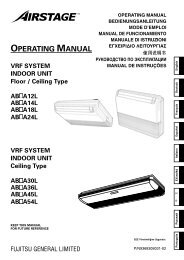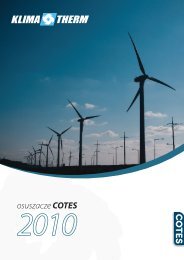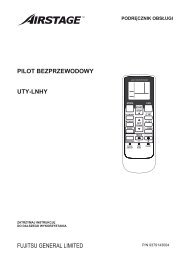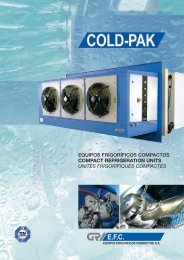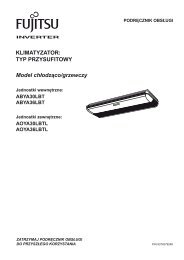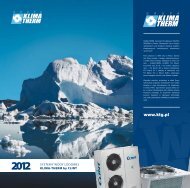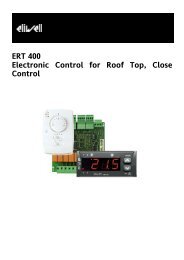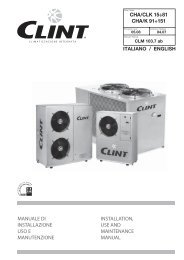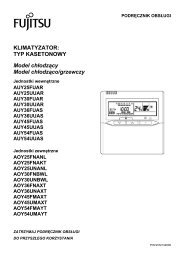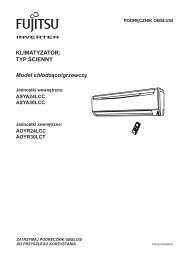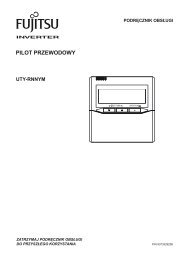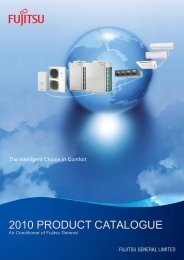marvin - Klima-Therm
marvin - Klima-Therm
marvin - Klima-Therm
Create successful ePaper yourself
Turn your PDF publications into a flip-book with our unique Google optimized e-Paper software.
3 Mobiletto di copertura<br />
È realizzato in lamiera d’acciaio preverniciata ad alta resistenza alla<br />
corrosione ed alla ruggine.<br />
4 Filtro aria<br />
Filtro lavabile a secco, in materiale acrilico, inserito in un robusto telaio<br />
in lamiera zincata.<br />
5 Telaio interno<br />
Costruito con lamiera zincata di elevato spessore con fori pretranciati<br />
per le varie configurazioni.<br />
6 Scarico condensa<br />
Permette lo scarico della condensa anche in condizioni particolari data<br />
la particolare capienza della vaschetta e il notevole diametro del tubo<br />
di scarico.<br />
7 Collegamenti idraulici<br />
I collegamenti idraulici si trovano normalmente nel fianco dx del ventilconvettore,<br />
a sx se viene ruotata la batteria di scambio termico, e sono<br />
da 1/2” G per qualsiasi modello.<br />
8 Batteria di scambio termico<br />
Costituita da una batteria alettata in tubi di rame ed alette corrugate<br />
in alluminio.<br />
9 Valvole sfiato aria<br />
Si trovano sugli attacchi idraulici della batteria e permettono lo sfiato<br />
dell’aria dalla batteria stessa.<br />
Installazione, collegamenti elettrici e avviamento / Installation, electrical connections and start-up<br />
2.1 Installazione del ventilconvettore<br />
Il ventilconvettore deve essere installato perfettamente orizzontale e<br />
in posizione che consenta di effettuare facilmente la manutenzione<br />
ordinaria (pulizia filtri) nonchè quella straordinaria.<br />
Per installare il ventilconvettore procedere nel seguente modo:<br />
• Togliere la copertura allentando le viti di fissaggio (Fig. A).<br />
• Se sono previsti i piedini, essi devono essere montati come da istruzioni<br />
in allegato agli stessi.<br />
• Fissare il gruppo ventilante alla parete o al soffito tramite viti a tassello<br />
(Fig. B verticale, Fig. C orizzontale).<br />
• Si consiglia di collegare l’entrata dell’acqua al raccordo inferiore.<br />
Collegare i tubi per l’alimentazione della batteria ed effettuare il collegamento<br />
dello scarico condensa.<br />
• I tubi di alimentazione idraulica devono essere isolati adeguatamente<br />
per evitare fastidiosi gocciolamenti in funzionamento di raffreddamento.<br />
• Per la raccolta dell’acqua che si forma sugli attacchi idraulici va utilizzata<br />
l’apposita vaschetta raccogli condensa (opzionale).<br />
• Lo scarico della condensa deve essere adeguatamente dimensionato<br />
e le tubazioni devono mantenere per tutta la loro lunghezza<br />
una pendenza che consenta un corretto deflusso della condensa.<br />
• Se lo scarico condensa dovesse confluire nella rete fognaria è<br />
necessario realizzare un sifone che impedisca la risalita verso l’ambiente<br />
di cattivi odori (Fig. E).<br />
• Riposizionare la copertura riavvitando le viti di fissaggio.<br />
Fig. A Fig. B<br />
Attenzione!<br />
Durante il collegamento dei tubi tenere con una chiave l’esagono<br />
di raccordo della batteria in modo da non provocare danni alla<br />
stessa (Fig. D).<br />
Nota<br />
È consigliata l’installazione del ventilconvettore ad una altezza inferiore<br />
ai 3 metri.<br />
Fig. C<br />
Fig. D<br />
3 Enclosure<br />
This is realized in pre-painted, rust and corrosion resistant sheet<br />
metal.<br />
4 Air filter<br />
Washable dry air filter in acrylic material, placed in a sturdy galvanized<br />
sheet metal frame.<br />
5 Internal frame<br />
Built in thick galvanized sheet metal with pre-punched holes for the<br />
various configurations.<br />
6<br />
Condensation discharge<br />
This makes it possible to discharge the condensation even in special<br />
conditions, due to the particular capacity of the tray and substantial<br />
diameter of the discharge pipe.<br />
7 Water connections<br />
The water connections are normally found on the rh side of the fan coil<br />
unit, on the lh side if the heat excange coil is field rotated, and they<br />
measure 1/2” G for all models.<br />
8 Heat exchange coil<br />
Copper pipes and carved aluminium finns.<br />
9 Air bleed valves<br />
These are found on the water connections of the coil and make it possible<br />
to bleed air from the coil.<br />
2.1 Installation of the fan coil unit<br />
The fan coil unit must be installed in a perfectly horizontal position and<br />
in a position that allows easy access for both routine maintenance (filter<br />
cleaning) as well as special maintenance.<br />
To install the fan coil unit proceed in the following manner:<br />
• Remove the enclosure by loosening the fastening screws (Fig. A).<br />
• If feet are included they must be mounted in accordance with the<br />
instructions provided with them.<br />
• Fasten the fan group to the wall or to the ceiling with the expansion<br />
screws (Fig. B vertical, Fig. C horizontal).<br />
• It is advisable to connect the water inlet to the lower coupling.<br />
Connect the pipes for the supply of the coil and connect the condensation<br />
discharge.<br />
• The water supply pipes must be adequately insulated to avoid bothersome<br />
dripping during cooling operation.<br />
• To collect the water that forms on the water connections, a special<br />
condensation collection tub is used (optional).<br />
• The discharge of the condensation must be properly sized, and the<br />
pipes must include over their entire length an inclination that allows for<br />
proper drainage of condensation.<br />
• If the condensation drain flows into the sewer system, it is necessary to<br />
realize a trap that prevents bad odors form entering the room (Fig. E).<br />
• Fix the enclosure by the fastening screws.<br />
Fig. E<br />
Attention!<br />
During connection of the pipes, always hold the coil coupling with<br />
a wrench to avoid damaging it. (Fig. D).<br />
Note<br />
We suggest installing the fan coil unit at a height not greater than 3<br />
meters.



